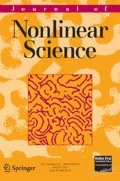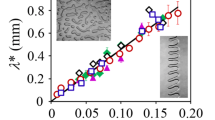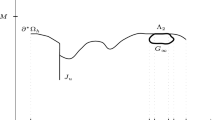Abstract
We study pattern formation in a compressed elastic film which delaminates from a substrate. Our key tool is the determination of rigorous upper and lower bounds on the minimum value of a suitable energy functional. The energy consists of two parts, describing the two main physical effects. The first part represents the elastic energy of the film, which is approximated using the von Kármán plate theory. The second part represents the fracture or delamination energy, which is approximated using the Griffith model of fracture. A simpler model containing the first term alone was previously studied with similar methods by several authors, assuming that the delaminated region is fixed. We include the fracture term, transforming the elastic minimisation into a free boundary problem, and opening the way for patterns which result from the interplay of elasticity and delamination. After rescaling, the energy depends on only two parameters: the rescaled film thickness, \({\sigma }\), and a measure of the bonding strength between the film and substrate, \({\gamma }\). We prove upper bounds on the minimum energy of the form \({\sigma }^a {\gamma }^b\) and find that there are four different parameter regimes corresponding to different values of a and b and to different folding patterns of the film. In some cases, the upper bounds are attained by self-similar folding patterns as observed in experiments. Moreover, for two of the four parameter regimes we prove matching, optimal lower bounds.









Similar content being viewed by others
References
Ambrosio, L., Coscia, A., Dal Maso, G.: Fine properties of functions with bounded deformation. Arch. Ration. Mech. Anal. 139, 201–238 (1997)
Ambrosio, L., Fusco, N., Pallara, D.: Functions of bounded variation and free discontinuity problems. In: Ball, J. M., Friedlander, E. M., Macdonald, I. G., Nirenberg, L., Penrose, R., Stuart, J. T. (eds.) Mathematical Monographs. Oxford University Press, Oxford (2000)
Annabattula, R.K., Veenstra, J.M., Mei, Y.F., Schmidt, O.G., Onck, P.R.: Self-organization of linear nanochannel networks. Phys. Rev. B 81, 224114 (2010)
Audoly, B.: Stability of straight delamination blisters. Phys. Rev. Lett. 83, 4124–4127 (1999)
Audoly, B., Boudaoud, A.: Self-similar structures near boundaries in strained systems. Phys. Rev. Lett. 91, 086105 (2003)
Audoly, B., Roman, B., Pocheau, A.: Secondary buckling patterns of a thin plate under in-plane compression. Eur. Phys. J. B 27, 7–10 (2002)
Bedrossian, J., Kohn, R.V.: Blister patterns and energy minimization in compressed thin films on compliant substrates. Commun. Pure Appl. Math. 68, 472–510 (2015)
Bella, P., Kohn, R.V.: Wrinkles as the result of compressive stresses in an annular thin film. Commun. Pure Appl. Math. 67, 693–747 (2014)
Bella, P., Kohn, R.V.: The coarsening of folds in hanging drapes. In: MPI-MIS Preprint 78/2015 (2015)
Ben Belgacem, H., Conti, S., DeSimone, A., Müller, S.: Rigorous bounds for the Föppl-von Kármán theory of isotropically compressed plates. J. Nonlinear Sci. 10, 661–683 (2000)
Ben Belgacem, H., Conti, S., DeSimone, A., Müller, S.: Energy scaling of compressed elastic films. Arch. Ration. Mech. Anal. 164, 1–37 (2002)
Bhattacharya, K., Fonseca, I., Francfort, G.: An asymptotic study of the debonding of thin films. Arch. Ration. Mech. Anal. 161, 205–229 (2002)
Bourne, D., Conti, S., Müller, S.: Folding patterns in partially delaminated thin films. In: Pandolfi, A., Weinberg. K. (eds) Innovative Numerical Approaches for Multi-field and Multi-scale Problems. Lecture Notes in Applied and Computational Mechanics, vol. 81, pp. 25–39 (2016)
Cendula, P., Kiravittaya, S., Mei, Y.F., Deneke, Ch., Schmidt, O.G.: Bending and wrinkling as competing relaxation pathways for strained free-hanging films. Phys. Rev. B 79, 085429 (2009)
Chambolle, A., Conti, S., Francfort, G.: Korn-Poincaré inequalities for functions with a small jump set. Indiana Univ. Math. J. 65, 1373–1399 (2016)
Choksi, R., Conti, S., Kohn, R.V., Otto, F.: Ground state energy scaling laws during the onset and destruction of the intermediate state in a type-I superconductor. Commun. Pure Appl. Math. 61, 595–626 (2008)
Choksi, R., Kohn, R.V., Otto, F.: Energy minimization and flux domain structure in the intermediate state of a type-I superconductor. J. Nonlinear Sci. 14, 119–171 (2004)
Conti, S., DeSimone, A., Müller, S.: Self-similar folding patterns and energy scaling in compressed elastic sheets. Comput. Meth. Appl. Mech. Eng. 194, 2534–2549 (2005)
Conti, S., Maggi, F.: Confining thin elastic sheets and folding paper. Arch. Ration. Mech. Anal. 187, 1–48 (2008)
Conti, S., Otto, F., Serfaty, S.: Branched microstructures in the Ginzburg–Landau model of type-I superconductors. SIAM J. Math. Anal. 48, 2994–3034 (2016)
Conti, S., Zwicknagl, B.: Low volume-fraction microstructures in martensites and crystal plasticity. Math. Models Methods Appl. Sci. 26, 1319–1355 (2016)
Gioia, G., Ortiz, M.: Delamination of compressed thin films. Adv. Appl. Mech. 33, 119–192 (1997)
Gioia, G., Ortiz, M.: Determination of thin-film debonding parameters from telephone-cord measurements. Acta Mater. 46, 169–175 (1998)
Huang, R., Im, S.H.: Dynamics of wrinkle growth and coarsening in stressed thin films. Phys. Rev. Lett. 74, 026214 (2006)
Ionov, L.: Biomimetic 3D self-assembling biomicroconstructs by spontaneous deformation of thin polymer films. J. Mater. Chem. 22, 19366–19375 (2012)
Jin, W., Kohn, R.V.: Singular perturbation and the energy of folds. J. Nonlinear Sci. 10, 355–390 (2000)
Jin, W., Sternberg, P.: Energy estimates of the von Kármán model of thin-film blistering. J. Math. Phys. 42, 192–199 (2001)
Kohn, R.V., Müller, S.: Branching of twins near an austenite—twinned-martensite interface. Philos. Mag. A 66, 697–715 (1992)
Kohn, R.V., Müller, S.: Surface energy and microstructure in coherent phase transitions. Commun. Pure Appl. Math. 47, 405–435 (1994)
Kohn, R.V., Nguyen, H.-M.: Analysis of a compressed thin film bonded to a compliant substrate: the energy scaling law. J. Nonlinear Sci. 23, 343–362 (2013)
Mei, Y., Thurmer, D.J., Cavallo, F., Kiravittaya, S., Schmidt, O.G.: Semiconductor sub-micro-/nanochannel networks by deterministic layer wrinkling. Adv. Mater. 19, 2124–2128 (2007)
Ortiz, M., Gioia, G.: The morphology and folding patterns of buckling-driven thin-film blisters. J. Mech. Phys. Solids 42, 531–559 (1994)
Pomeau, Y.: Buckling of thin plates in the weakly and strongly nonlinear regimes. Philos. Mag. B 78, 235–242 (1998)
Vandeparre, H., Piñeirua, M., Brau, F., Roman, B., Bico, J., Gay, C., Bao, W., Lau, C.N., Reis, P.M., Damman, P.: Wrinkling hierarchy in constrained thin sheets from suspended graphene to curtains. Phys. Rev. Lett. 106, 224301 (2001)
Zwicknagl, B.: Microstructures in low-hysteresis shape memory alloys: scaling regimes and optimal needle shapes. Arch. Ration. Mech. Anal. 213, 355–421 (2014)
Acknowledgments
The authors would like to thank O. G. Schmidt and other members of the Institute for Integrative Nanosciences, IFW Dresden (including P. Cendula, S. Kiravittaya and Y. F. Mei) for interesting discussions about the experiments that were the motivation for this paper. This work was partially supported by the Deutsche Forschungsgemeinschaft through the Sonderforschungsbereich 1060 “The mathematics of emergent effects.”
Author information
Authors and Affiliations
Corresponding author
Additional information
Communicated by Irene Fonseca.
Appendices
Appendix 1: Derivation of the Model and Rescaling
In this appendix, we derive the energy (1.1). We model the two-layer material (an elastic film on a substrate) described in the introduction with an energy consisting of two parts, an elastic energy for the thin film and a bonding energy for the interaction between the film and the substrate. We take the elastic energy to be the von Kármán energy, which penalises extension (stretching and compression) and bending:
where \(\Omega = (0,l_1) \times (0,l_2)\) is the set of material points (x, y) of the film, \(h_\text {f}\) is the thickness of the film, E is the Young’s Modulus, and \(\nu \) is the Poisson ratio. The functions \({\varvec{u}}(x,y) = (u(x,y),v(x,y))\) and w(x, y) are the in-plane and transversal (vertical) displacements of the film from the isotropically compressed state \(((1-\varepsilon _*)x,(1-\varepsilon _*)y,0)\), where \(0<\varepsilon _*<1\) is the compression ratio. Note that \({\varepsilon }_*=0\) corresponds to no compression and \({\varepsilon }_*=1\) corresponds to total compression. Thus, \((u,v,w)=(0,0,0)\) corresponds to the isotropically compressed state of the film and \((u,v,w)=(\varepsilon _* x,\varepsilon _* y,0)\) corresponds to the relaxed, natural state. The substrate is taken to be at height \(z=0\). Therefore, the transversal displacement w must satisfy the constraint \(w \ge 0\) (since the film cannot go below the substrate). If \(w(x,y)=0\), then the material point (x, y) of the film is bonded down to the substrate.
For the energy scaling analysis that we perform, we can set the Poisson ratio \(\nu \) equal to zero without loss of generality since the terms of (6.43) with value of \(\nu \) in the physical range \((-1,1/2)\) can be bound from above and below by those without, as shown in Ben Belgacem et al. (2000, Appendix B).
The interfacial force between the thin film and the substrate is an attractive van der Waals force. We model it in a simple way with a bonding energy \({\hat{I}}_{\text {Bo}}\) that penalises debonding from the substrate:
where \({\gamma }^*\) is a constant depending on the material properties of the film and the substrate. In more sophisticated models, \(I_{\text {Bo}}\) would also depend on the size of w, i.e. how far the film is from the substrate.
Thus, the total energy we assign to the system is
On the boundary \(\{x=0\}\), we assume that the film is fixed to the substrate and satisfies the clamped boundary conditions
(Note that in the experiments of Mei et al. (2007), the film is actually fixed to a buffer layer and satisfies slightly different boundary conditions. This is discussed in Appendix 2) The film is free on the rest of its boundary, \(\{x=l_1\} \cup \{y=0\} \cup \{y=l_2\}\).
Rescaling In order to reduce the number of parameters, we define rescaled variables, denoted with a superscript \(*\), by
By substituting from Eq. (6.47) into Eq. (6.45), multiplying by \(2 (1-\nu ^2) / (E h_\mathrm {f} \varepsilon _*^2)\), setting \(\nu =0\), and dropping all the superscripts * for convenience, we obtain a new energy \(I^{({\sigma },{{\gamma }})}\):
where \({\sigma }\) is the rescaled film thickness and \({{\gamma }}\) is the rescaled bonding energy per unit area:
Throughout this paper, we refer to \({{\gamma }}\) as the bonding strength, although note that it also depends on the unscaled film thickness \(h_{\text {f}}\). Equation (6.48) is exactly Eq. (1.1) given in the Introduction.
Appendix 2: Upper Bounds for Buffer Layers with Nonzero Thickness
In the experiments of Mei et al. (2007), the film is not clamped to the substrate, but rather to a thin buffer layer, and satisfies clamped boundary conditions of the form
where \(h_\mathrm {b}>0\) is the thickness of the buffer layer. In this paper, we considered the unphysical case \(h_\mathrm {b}=0\) in order to simplify the analysis. In this appendix, we show that the upper bounds of Theorem 2.1 also hold when \(h_\mathrm {b}\) is sufficiently small. Recall that \(\Omega = (0,l_1)\times (0,l_2)\). Define
Theorem 6.8
(Upper Bounds for \(h_{\text {b}} >0\)) Let \(0<l_1\le l_2, {\sigma }\in (0,1), {{\gamma }}\ge 0\). Assume that \(h_{\text {b}}\) satisfies
Then, there exists admissible displacement fields \(({\varvec{u}},w) \in V_{h_{\text {b}}}\) satisfying the same upper bounds as in Theorem 2.1.
Proof
We construct displacement fields satisfying the required upper bounds by simply appending to the constructions used to prove Theorem 2.1 a boundary layer in which the film is bent upwards from height 0 to height \(h_{\text {b}}\). Let \(\eta >0\) be the boundary layer thickness. For \(x \in [0,\eta ], y \in [0,l_2]\) define
where \(\psi \in C^2({\mathbb {R}})\) is a function with \(\psi (t)=0\) for \(t\le 0, \psi (t)=1\) for \(t\ge 1\). For \(x \ge \eta \), define u, v, w as in the proof of Theorem 2.1 (except that u is replaced with \(u + \eta /2\)). The energy \(E_{\text {BL}}^\eta \) of (u, v, w) in the boundary layer \((0,\eta )\times (0,l_2)\) satisfies
since we assumed that \(h_{\text {b}} \le {\sigma } l_1\). We choose
so that
For each regime, it is easy to check that this boundary layer energy is no greater than the energy of the constructions given in Theorem 2.1. \(\square \)
This is the simplest possible modification of the proof of Theorem 2.1, and we do not claim that the bound \(h_{\text {b}}/l_1 < \min \{{\sigma },{\sigma }^{-1} {{\gamma }}^{-3/2}\}\) is sharp.
Appendix 3: Poincaré Constant
In this section, we prove the Poincaré inequality (3.2). It is sufficient to prove the following:
Lemma 6.9
Let \(Q=(0,1) \times (0,1)\) be the unit square and \({\varvec{f}}\in {W^{1,2}}(Q;{\mathbb {R}}^2)\). Let \({\varvec{f}}\) be zero on at least half of the square:
Then,
Proof
First we recall the Poincaré inequality in one dimension. Let \({\varvec{g}}\in C^1([0,1]; {\mathbb {R}}^2)\). Write \({\varvec{g}}\) as the Fourier cosine series (the Fourier series of the even extension of g to \([-1,1]\))
Let \(\overline{{\varvec{g}}} = {\hat{{\varvec{g}}}}_0/2 = \int _0^1 {\varvec{g}}(x) \, {\text {d}}x\). By Parseval’s Theorem
which is the Poincaré inequality in one dimension. By density, the same holds for \({\varvec{g}}\in W^{1,2}((0,1);{\mathbb {R}}^2)\).
We now turn to the two-dimensional case. By Fubini’s theorem, for almost every x one has \({\varvec{f}}(x,\cdot )\in W^{1,2}((0,1);{\mathbb {R}}^2)\). Let
By equation (6.55)
Therefore,
Let \(U = \{ {\varvec{x}}\in Q : {\varvec{f}}({\varvec{x}}) = {\mathbf {0}} \}\). We have
Observe that
By combining this with estimates (6.56) and (6.57), we obtain
which, since \(6<\pi ^2\), completes the proof. \(\square \)
Rights and permissions
About this article
Cite this article
Bourne, D.P., Conti, S. & Müller, S. Energy Bounds for a Compressed Elastic Film on a Substrate. J Nonlinear Sci 27, 453–494 (2017). https://doi.org/10.1007/s00332-016-9339-0
Received:
Accepted:
Published:
Issue Date:
DOI: https://doi.org/10.1007/s00332-016-9339-0




